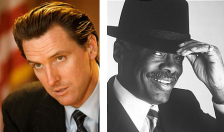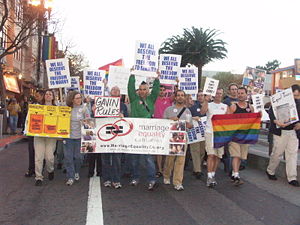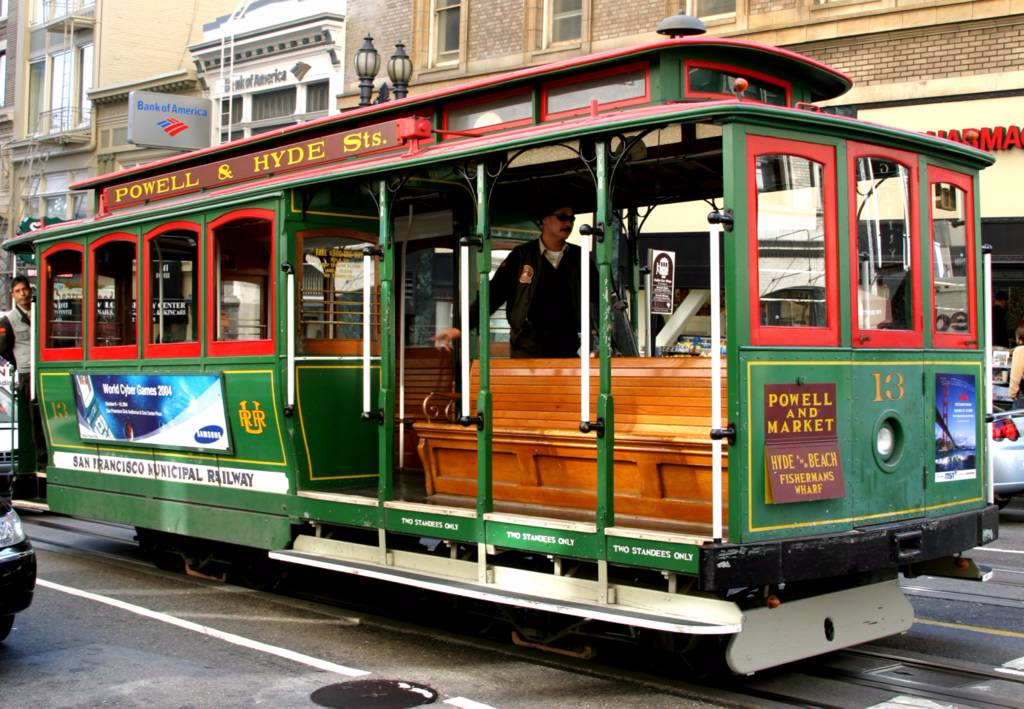San Francisco Bay Guardian - June 16, 1999
RUN, TOM, RUN
Why the city’s outspoken board president should enter the mayor’s race – and how he could even win.
By Savannah Blackwell, Tim Redmond, and Gabriel Roth
The fanfare at Yerba Buena Saturday seemed more than a little strained. Despite his best efforts, Mayor Willie Brown’s gala campaign kickoff celebration wound up underscoring his vulnerability.
As he heads into his reelection campaign, nearly three out of four voters are displeased with him, according to a recent poll in the San Francisco Examiner. City residents are tired of hearing about the mayor’s jet-setting glamour while the buses they take to work don’t show up.
Brown was apparently so nervous about the upcoming election that he packed the June 12 kickoff with high-powered supporters – to the point of overkill. Rev. Cecil Williams invoked the Lord. Gov. Gray Davis read a letter of support from President Bill Clinton, then said Brown’s public support was so great the election itself was unnecessary. U.S. rep. Nancy Pelosi beamed in her blessings. State sen. John Burton stood by.
Brown’s campaign sent out 60,000 invitations. The house was packed with Brown appointees and the gangs of friends they were asked to bring. Willie himself took the stage while gospel choir Sould Out belted “We Are Family” – a performance aimed, no doubt, at driving home the message that the entire political community (everybody who matters, anyway) is behind him.
The mayor has good reason to worry. Fed up with authoritarian governing that has failed to improve public services, much less fix major economic and social problems, San Franciscans of all political leanings are itchy for a better option.
That’s why so many people are showing up at political events wearing buttons reading “Run, Tom, Run.”
Board of Supervisors president Tom Ammiano says he’s still making up his mind whether or not to run for mayor. But the possibility is generating plenty of excitement. Unless Ammiano throws his hat in the ring, voters who aren’t happy with Brown and who don’t see longtime political consultant Clint Reilly or (gasp) former mayor Frank Jordan as credible alternatives have nobody to vote for in November.
San Francisco is in the grip of a serious socioeconomic and political crisis. Downtown and city coffers may be flush, but low- and moderate-income residents are being forced out in droves by skyrocketing housing costs. Evictions are on the rise. Thousands still have nowhere to live. The city’s health care system is near collapse. Gentrification is destroying San Francisco’s treasured diversity.
Meanwhile, the mayor’s political machine rules the city with an iron grip. Insiders get fat contracts while the neighborhoods get nothing. The workings of city government are shrouded in secrecy. Democracy itself is being undermined.
That’s why it’s critical that there be a candidate on the ballot who’s independent of the entrenched political culture – one who will put the interests of ordinary people first. And that’s why Tom Ammiano should run for mayor.
“[For] a lot of the people that are urging him to run, it’s not just that they’re fed up with Willie, it’s that Tom represents working people. He’s a politician who actually has policy and who actually believes in something – as opposed to just buying into the machine and looking into whatever he can do to promote himself,” Phillip Babcock, and activist with the Harvey Milk Lesbian/Gay/Bisexual/Transgender Democratic Club and San Francisco Tomorrow, told the Bay Guardian. “It makes a big difference when you go into someone’s office and know you can argue for something and that person will actually base their decision on whether they think it’s a good idea – as opposed to basing it on what some political boss says.”
All Brown’s campaign will say about the mayor’s possible rival is that Ammiano hasn’t announced yet. “We are taking Mr. Ammiano at his word that he is not a candidate,” Eric Jaye, who is handling Brown’s media, told us.
Tom Pier, communications director for the Reilly campaign, was more forthcoming. “We hope he can provide his ideas on solving some of the vexing problems of the city, such as homelessness and Muni,” Pier told us. “As president of the Board of Supervisors, Ammiano has been in a position to show leadership on both of those issues – and to date, they’re still issues that haven’t been appropriately addressed in the eyes of the citizenry.”
Ammiano says he will make a decision – one that will affect the rest of his political career – within the next two weeks. He knows campaigning for mayor would take a total commitment and a lot of work. And he has enough humility to know he may not have all the answers – should he win.
“I think the time is ripe. And I’m on the street a lot, walking, taking the Muni. I am holding back only because of what the personal commitment is in terms of time and energy and what it means to other people. I don’t want to let other people down. I either jump in fully committed or not at all,” Ammiano told the Bay Guardian. “The promise of what could happen is exciting. But people need to realize that the problems with San Francisco governance – all of those problems are very systemic. No mayor can be a miracle person. Everything would not be resolved with my election within three months.”
Local hero
Whatever decision Ammiano makes, he’s earned the loyalty of the progressive community.
“People are either viscerally or overtly trying to send good messages to Tom,” environmental activist and political consultant Ross Mirkarimi told us. “They’ll understand if he doesn’t do it, but either way, it positions him beautifully for whatever else is to come. Tom has a genuine following that loves him and will sustain itself either way.”
Ammiano’s office at City Hall is the emergency room for the city’s down-and-out – struggling activist groups and struggling individuals. No one listens to and tries to do something about, as many tales of woe as Ammiano. And no one is raising as wide a range of left issues.
Ammiano has been a leader on the gamut of progressive causes. He’s championed open-government and campaign-reform legislation. He’s introduced measures to raise taxes on business. Low-paid employees of city contractors would enjoy higher wages under another of his proposals. Being the only supervisor who rides Muni, with its mind-boggling array of problems, everyday helped Ammiano secure the board presidency. That issue is sure to hurt Brown, who initially claimed he would fix the system within 100 days of taking office. Even the mayor, with all his hubris, has had to admit that he made a mistake on that one. San Francisco’s il duce hasn’t made the trains run on time.
If Ammiano’s in the race, progressives will have a good reason to turn out at the polls in November. If only Brown and Reilly are on the ballot, a lot of progressive voters will stay home. That would hurt the Sunshine Initiative, help Earl Rynerson’s draconian welfare measure (see S.F. Confidential, 4/14/99), and leave the left defeated and demoralized.
What’s more, Ammiano is a great campaigner – quick, funny, genuine, and immediately likable. His campaign would galvanize the progressive community. That alone is a good reason for him to run.
The odds are very good that he would make a runoff – and he might even have a chance to win.
“Given that so many voters are anti-Brown right now, and Ammiano has so much credibility with so many of these voters, there’s a good chance Ammiano comes in second and makes it into a runoff,” pollster David Binder, who is not working for any mayoral campaign, told the Bay Guardian.
Back to his roots
If he runs, Ammiano will certainly be outspent by both his chief rivals. He doesn’t have Brown’s Democratic Party connections or Reilly’s personal fortune. He’s made a point of pissing off the big businesses that give so generously to establishment candidates. So he’d be dependent on small local contributors and a loose nationwide network of gay activist donors. The campaign watchers we talked to agree that he couldn’t really think about mounting a credible campaign – even a shoestring one – for less than a quarter of a million dollars. Even that’s painfully low, with Reilly planning to spend at least two million and Brown trying hard to keep up. But for Ammiano, it’s a big chunk of money that would require a lot of work to raise.
Everyone agrees he doesn’t need to equal his rivals’ financial firepower. If Ammiano succeeds, it will be through an old-fashioned grassroots campaign driven not by money but by an energetic team of volunteers. San Franciscans respond well to candidates who get their message out by knocking on doors and setting up tables on busy corners rather than by sending out expensive mailers and running ads on TV.
Robert Haaland of the San Francisco Tenants Union suggests Ammiano run the same kind of campaign that tenant activists ran last year to defeat Proposition G, which would have gutted eviction protections. “Prop. E’s backers spent three quarters of a million dollars, and we spent under $30,000,” he told us. “We didn’t do mailings; we did volunteer literature drops. We had 40 people out every weekend. That’s the kind of campaign Tom needs.”
Such a campaign would serve to consolidate and expand Ammiano’s base. He can count on progressives and much of the queer vote, but he needs to court the more moderate gays and straights who might be turned off by his economic leftism. And while many white lefties, tenants, and environmentalists would vote for him in a heartbeat, he would have to make an effort to sell himself to communities of color fed up with Brown’s hyperdevelopment agenda and broken promises.
One sector of his base might give him more trouble in November. Ammiano’s biggest handicap may turn out to be the ambivalence or opposition of organized labor. The unions have supported him in all his board campaigns, drawn to his side not only by his worker-friendly votes on contract issues but also by his general economic egalitarianism. They’ve given him more than money: an aggressive door-knocking campaign by union members helped win him votes last year.
But Brown secured the San Francisco Labor Council’s endorsement for a second term more than a year ago, in a move that might have been calculated to discourage Ammiano from running. If Ammiano does decide to challenge the mayor, he’ll have to do so without the explicit support of this important part of his base.
Sources in the labor movement, speaking anonymously, differ as to how unions would respond to an Ammiano campaign. Some say labor has already picked its candidate and there’s no way any but a few maverick unions could back a challenger.
But others point out that the decisions of union leaders can’t always motivate members to volunteer to get the vote out. Brown certainly has the enthusiastic support of the building trades, cheered by the recent development boom. Some public employees also feel they’re in his debt - and plenty of them would be reluctant to publicly oppose him.
But many rank-and-file union members are more enthusiastic about Ammiano, who has championed worker-friendly measures, such as a living-wage guarantee, in the face of political opposition.
“If Tom was in there, labor would have trouble mobilizing the ranks for Brown,” one union source told us.
There’s already a grassroots campaign to convince Ammiano to throw his hat in the ring, organized by Haaland and fellow queer tenant activist Jerry Threet. The “Run, Tom, Run” campaign has collected a couple thousand petition signatures, launched a Web site (www.ammiano4mayor.com), and handed out hundreds of buttons – all to demonstrate the extent of the public’s support for an Ammiano campaign.
“As soon as we started doing it, we were swamped with people wanting to sign the petition,” Threet told us. “The petition also includes spaces for people to offer to volunteer [to work on the campaign] or to give money, and most people said they’d do both.”
Those buttons have already become a fixture of the race. Threet and Haaland showed up with a bagful at the Milk Club’s annual dinner, where Ammiano was presented with the Harry Britt Lifetime Service Award, and, according to Threet, “they were gone in a flash. Before Tom started speaking, everybody was chanting, ‘Run, Tom, run,’ and they kept on and on.”
Crowded field
By entering the race when nobody else would, political consultant Reilly may have opened the door for an Ammiano run. If Reilly hadn’t broken the ice by challenging Brown, it’s unlikely Ammiano (or anyone else) would consider a run.
To his credit, Reilly is running an anticorruption, antigrowth campaign. He’s in favor of, and helping on, the open-government Sunshine Initiative. He can use his millions to make the case to the public that the mayor’s cronyism is ruining the city. Reilly is running against downtown development, against expensive yuppie lofts, and against corporate welfare deals such as the 49ers stadium and Mission Bay. He is independent of machine politics.
That said, Reilly is hardly the progressive alternative to Brown. He ran the insurance industry’s campaign against Ralph Nader and Harvey Rosenfeld’s insurance reform initiative. He supports passing on half the cost of property-tax bonds to tenants. He hasn’t come out against privatizing the Presidio. He hasn’t come out for public power. And even his own staff agrees that on fiscal and taxation issues, he’s pretty conservative.
Former mayor Jordan and Sup. Leland Yee have also both publicly considered running. Observers are divided on the impact Jordan would have if he entered the race. Some say he presided over such a dismal time in San Francisco that he has no chance at all; others say his average-guy appeal could help him against Brown and his air of noblesse oblige.
Everyone agrees he’d hurt Reilly’s chances by taking away conservative votes.
Yee’s entrance, some say, could give Ammiano a huge boost by taking Asian voters from Brown. He’d have little chance of making it into a runoff – but if he loudly endorsed Ammiano after the main election, some of his voters might follow.
Taking the high road
Here’s one plausible scenario by which Ammiano could come to occupy the mayor’s office: According to Binder, Brown gets the votes of moderate straight white Democratic men, some Asians, most African Americans, and some straight white women. Ammiano gets the majority of the gay and straight-progressive vote – likely more than the 60 percent that lesbian leader Roberta Achtenberg got in her 1995 bid for mayor.
According to pollsters and other experts, 15 to 17 percent of the vote is likely to be queer. Straight progressives account for another 20 percent. Sixty percent of 35-37 percent gives Ammiano 22 percent of the total vote.
Ammiano also gets some of the more moderate voters – but just how many is hard to predict. In the 1998 board race, he got a surprisingly large number of votes from more conservative neighborhoods like the Excelsior and the Sunset. It’s safe to say most of those voters don’t share his ideology. Some are union members who appreciate that he’s been a friend to labor; others like that he’s independent of the mayor and has pushed good-government reforms.
But Binder and others note that Ammiano cannot count on the anti-Brown sentiment working for him in a mayor’s race the way it did in his bid for the board presidency.
“Ammiano is the true heir to the Harry Britt/Harvey Milk willingness to take risks and say and do things that sometimes seem outrageous but resonate with the populist leanings of the people,” longtime San Francisco political consultant Jim Rivaldo, who ran campaigns for both Britt and Milk, says. That makes him a popular candidate when he runs for one of 11 board seats, but, Rivaldo says, “that doesn’t necessarily translate into people believing that person should be the executive.”
Ammiano would have to court moderates – especially individual home owners, seniors, and residents of the west side of town, consultants say.
If no candidate wins a majority of votes, the first- and second-place candidates face each other in a runoff. In the runoff, the tone would be set by the main campaign. If Brown loses his cool and starts attacking his opponents, and Ammiano stays above the fray, some of the conservative Brown haters who voted for Reilly or Jordan in the election could switch to Ammiano in the runoff.
That’s essentially what happened in 1987, when Art Agnos, John Molinari, and Roger Boas ran for mayor. Molinari so pissed off conservative Boas voters that a significant number of them backed the more liberal Agnos over Molinari in the runoff.
Stuck in the middle
Another possible scenario: Brown’s negative poll ratings are at 30 percent – the highest they’ve been since he took office. His hard-core support is relatively limited and already firmly established.
If Ammiano enters the race, Brown remains the front-runner, but Ammiano and Reilly wind up in a close heat for second. Ammiano pulls support away from both Reilly and Brown, but pulls more from Brown.
Conventional wisdom holds that an Ammiano candidacy would help Reilly by taking liberal voters away from Brown. But Reilly campaign staffer Pier, for one, thinks another challenger could be a mixed blessing.
“Reilly is to the left of the mayor on a lot of issues, and Ammiano coming in could deprive us of the chance to make that contrast with the mayor as clear as we might,” he told us.
With Ammiano in the race, Reilly is likely to take the right for granted, forget the left, and hammer very hard at the center-moderates. Ammiano will push very hard on the left. If Reilly’s lethargic campaign perks up, Brown could lose conservative and moderate support to Reilly and/or Jordan and liberal support to Ammiano – and be left with a smaller and smaller chunk of the middle. And in San Francisco politics, the center is never a good place for a candidate to be. (In 1975 Dianne Feinstein lost what she though was a sure shot at mayor when she was squeezed between George Moscone on the left and John Barbagelata on the right.)
A caveat: Any scenario in which Brown does not make the runoff is extremely unlikely. Brown has the advantage of incumbency; what’s more, he’s got a huge, well-seasoned campaign operation and a long list of potential donors to call.
Then there are some 3,000 city employees who will take Election Day off and work for him. He’s nailed some key endorsements well in advance – not just the Labor Council but also the Democratic County Central Committee. And he has a very sophisticated voter registration drive under way in the black community.
If Ammiano and Jordan jump in, that makes it a four-way race – and that might help the mayor.
“When nobody else was officially running, and it was Willie Brown against Willie Brown, he didn’t look so good,” one consultant told us. “Now that it’s Willie Brown against Tom Ammiano, or Willie Brown against Clint Reilly, to a lot people he doesn’t look so bad.”
So it would be a tough battle for Ammiano. But wouldn’t it be worth a shot? Wouldn’t it be worth giving San Francisco the chance to elect the first openly gay mayor – and one who comes from the honorable oppositional tradition of Harvey Milk?
“Tom is a working-class guy who’s never made more than $50,000 a year,” Babcock told the Bay Guardian. “We have to have someone who’s looking out for our future and willing to put qualified people in power. He’s strong enough to listen to people who disagree, but most importantly, he gets real people’s issues.” ■
|
VOTE FOR SUPERVISOR AMMIANO BY NEIGHBORHOOD |
|
|
CENTRAL S.F. AND EAST SIDE |
PERCENT OF DISTRICT |
|
Civic Center, Downtown |
55 |
|
Diamond Heights |
53 |
|
Haight Ashbury |
63 |
|
Inner Sunset |
55 |
|
Mission |
65 |
|
Noe Valley |
62 |
|
North Bernal Heights |
68 |
|
Potrero Hill |
60 |
|
South Bernal Heights |
60 |
|
South of Market |
52 |
|
Upper Market, Eureka Valley |
71 |
|
Western Addition |
61 |
|
NORTH SIDE |
PERCENT OF DISTRICT |
|
Chinatown |
42 |
|
Laurel Heights, Anza Vista |
46 |
|
Marina, Pacific Heights |
40 |
|
North Embarcadero |
44 |
|
Richmond |
44 |
|
Sea Cliff, Presidio Heights |
37 |
|
SOUTH SIDE |
PERCENT OF DISTRICT |
|
Bayview-Hunters Point |
38 |
|
Excelsior |
39 |
|
Ingleside |
37 |
|
Visitacion Valley |
36 |
|
WEST SIDE |
PERCENT OF DISTRICT |
|
Lake Merced |
38 |
|
Sunset |
37 |
|
West Twin Peaks |
38 |
This chart shows the percentage of voters by neighborhood who voted for Tom Ammiano in the 1998 supervisorial elecrion. Ammiano’s support is strongest in the city’s liberal east side. While Ammiano comfortably won more votes than any other candidate last year, he’ll need to build support in other areas of the city if he enters the mayor’s race.







